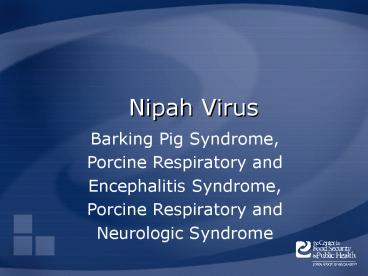Pigs ... Pigs. Direct contact. Contact with body fluids - PowerPoint PPT Presentation
Title:
Pigs ... Pigs. Direct contact. Contact with body fluids
Description:
Pigs ... Pigs. Direct contact. Contact with body fluids. Aerosolization of ... with potentially infected pigs. IMMEDIATELY contact state authorities ... – PowerPoint PPT presentation
Number of Views:375
Avg rating:3.0/5.0
Title: Pigs ... Pigs. Direct contact. Contact with body fluids
1
Nipah Virus
- Barking Pig Syndrome,
- Porcine Respiratory and
- Encephalitis Syndrome,
- Porcine Respiratory and
- Neurologic Syndrome
2
Overview
- Organism
- History
- Epidemiology
- Transmission
- Disease in Humans
- Disease in Animals
- Prevention and Control
- Actions to Take
3
Agent
- Genus Henipavirus
- Virus discovered, 1999
- Related to Hendra virus
- Severe, rapidly progressive encephalitis in
humans - High mortality rate
- Close contact with infected pigs
- Severe, respiratory disease in pigs
4
History
5
History
- 1998-1999 Peninsular Malaysia
- Human febrile encephalitis, high
mortality - New virus discovered
- 1999 Singapore
- Outbreak in abattoir workers
- Pigs imported from Malaysia
- Since 2001 Bangladesh, India
6
(No Transcript)
7
Transmission
8
Reservoir
- Flying foxes (fruit bats)
- Carry the virus
- Are not affected
- Virus found in
- Urine
- Partially eaten fruit (saliva?)
- No known secondary host
9
Transmission
- Pigs in Malaysia
- Direct contact
- Contact with body fluids
- Aerosolization of respiratory or urinary
secretions - Vertical transmission across the placenta?
- Semen and iatrogenic spread?
10
Transmission
- Person-to-person
- Not reported in Malaysia
- Likely in Bangladesh and India
- Nosocomial infections
- Bat-to-person
- Not reported in Malaysia
- Common in Bangladesh and India
- Contaminated fruit, unpasteurized date palm juice
11
Photo courtesy of James Roth, DVM, PhD, ISU
12
Photo courtesy of James Roth, DVM, PhD, ISU
13
Epidemiology
14
Epidemiology
- 1998-1999 Malaysia
- 265 persons hospitalized 105 deaths
- Primarily adult males with swine contact
- Disease in swine
- Severe respiratory disease
- Transmitted by movement of infected pigs
- 1.1 million pigs culled
- Great economic loss
- Surveillance and testing
15
Epidemiology
- 1999 Singapore
- 22 seropositive persons (1.5)
- All were male abattoir workers
- 12 symptomatic
- Encephalitis, pneumonia, or both
- 10 asymptomatic
16
Epidemiology
- 2001 Siliguri, India
- Nosocomial transmission
- 2004 Bangladesh
- 34 cases 26 deaths
- Transmission
- Close contact
- Exposure to common source
17
Epidemiology
- 2005 Bangladesh
- 44 cases 12 deaths
- Contaminated palm fruit juice
- 2007 Bangladesh
- 7 cases 3 deaths
- Person-to-person transmission
18
Disease in Humans
19
Human Illness
- Incubation period 4 to 20 days
- Fever and headache
- Encephalitis
- Dizziness, drowsiness, vomiting
- Seizures
- Progresses to coma in 24-48 hours
- Respiratory difficulty
- Relapsing neurologic symptoms
20
Human Illness
- Complications (Malaysian outbreak)
- Septicemia (24)
- GI bleeding (5)
- Renal impairment (4)
- Asymptomatic
- Relapse or late-onset encephalitis
- Residual neurological deficits
- Treatment Supportive, ribavirin
21
Disease in Animals
22
Disease in Animals
- Pigs
- Highly contagious
- May be asymptomatic
- Acute fever (gt104F)
- Severe respiratory disease
- Characteristic cough harsh, barking
- Neurological changes
- Low mortality
23
Disease in Animals
- Dog
- Distemper-like signs
- Fever, respiratory distress
- Ocular and nasal discharge
- Cat
- Fever, depression
- Severe respiratory signs
- Horses
- Encephalitis
24
Sampling
- Before collecting or sending any samples, the
proper authorities should be contacted - Samples should only be sent under secure
conditions and to authorized laboratories to
prevent the spread of the disease
25
Diagnosis
26
Diagnosis
- Differentials for swine
- Classical swine fever, PRRS, pseudorabies, swine
enzootic pneumonia, porcine pleuropneumonia - Diagnostic tests
- ELISA
- Immunohistochemistry
- PCR
- Virus isolation
27
Prevention and Control
28
Recommended Actions
- IMMEDIATELY notify authorities
- Federal
- Area Veterinarian in Charge (AVIC)
- http//www.aphis.usda.gov/animal_health/area_offic
es/ - State
- State veterinarian
- http//www.usaha.org/StateAnimalHealthOfficials.pd
f - Quarantine
29
Prevention and Control
- Keep fruit bats away from pigs
- Do not drink unpasteurized fruit juices
- Wash, peel, and/or cook all fruit thoroughly
before eating
30
Nipah as a Biological Weapon
- CDC Category C Bioterrorism Agent
- Emerging pathogen
- Potentially high morbidity and mortality
- Major health impact
- Aerosolization potential
- Economic impact
- Social disruption (fear, panic)
31
Additional Resources
- World Organization for Animal Health (OIE)
- www.oie.int
- U.S. Department of Agriculture (USDA)
- www.aphis.usda.gov
- Center for Food Security and Public Health
- www.cfsph.iastate.edu
- USAHA Foreign Animal Diseases(The Gray Book)
- www.usaha.org/pubs/fad.pdf
32
Acknowledgments
- Development of this presentationwas funded by
grants from - the Centers for Disease Control and Prevention,
the Iowa Homeland Security and Emergency
Management Division, and the Iowa Department of
Agriculture and Land Stewardship to the Center
for Food Security and Public Health at Iowa State
University. - Authors Glenda Dvorak, DVM, MPH, DACVPM James
A. Roth, DVM, PhD - Reviewers Radford Davis, DVM, MPH Jean Gladon,
BS Bindy Sornsin, BS Katie Spaulding, BS Kerry
Leedom Larson, DVM, MPH, PhD































